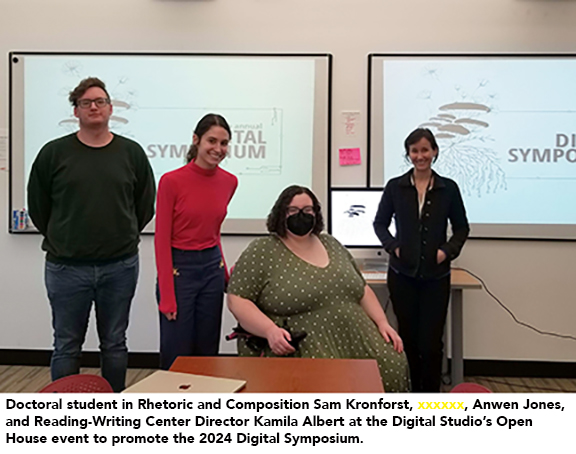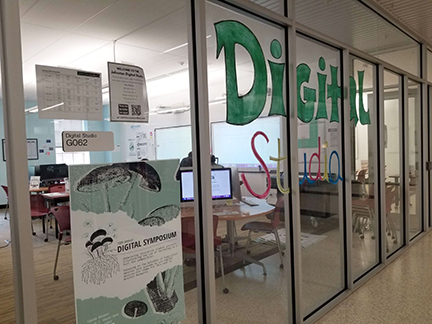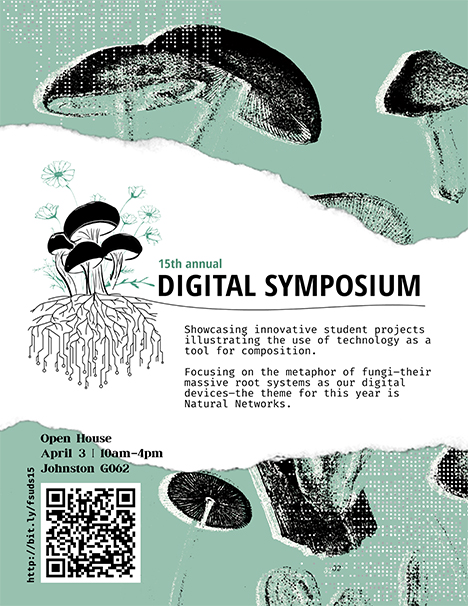Digital Symposium showcases students' online presentations with technological theme of fungi-like “Natural Networks”
Article and photos by Gabriel Roque
The Department of English recently made live its Digital Symposium website, continuing an annual event that is now in its 15th year. On the site, students showcase their achievements in scholarship and class work, focused primarily on digital media, whether it be artifacts such as videos and websites or professional portfolios. This year's theme is “Natural Networks.”
Despite its current nature as an online-only event, the symposium’s heart lies in the real world.
Two Digital Studios are located on Florida State University’s campus: one on the second floor in the Williams Building and one on the ground floor in William Johnston Building. The former is used only for small meetings, while the latter serves as the base of operations for the Digital Symposium, in addition to being a year-round resource for students working on class projects.
Both spaces emphasize creativity and collaboration. Digital Studio consultants are available to help students at any stage of their projects: they assist in brainstorming, provide feedback, or even explain the interface of a digital design program. Much like the studios, the Digital Symposium is about an exchange of ideas and an exploration of selves. The website is akin to a living, breathing entity, and part of that is because of who is behind the operation.
Anwen Jones is the coordinator of this year’s Digital Symposium, and she recently graduated from FSU with her Master of Arts degree in Rhetoric and Composition. A graduate from Scripps College in Portland, Oregon, Jones says she was first drawn to FSU because of its “excellent Rhetoric and Composition Program and disability-awareness.”
"I started working in the Digital Studio and the Reading Writing Center the first semester of my master’s degree, and I pretty quickly fell in love with it,” Jones says. “Our director, Dr. Kamila Albert, is incredible. She is both impressively intelligent and capable and really embodies this ethic of care in making this space for people to improve and progress as human beings. Yes, as a consultant and as a writer, but also for who you are regardless of the labor you're doing."
Jones, like many of the students at the Digital Studio, has a great interest in teaching. For her, becoming this year’s symposium coordinator was a natural decision; she also believes in the flexibility that an online-only event can bring.
"I teach online, asynchronous classes for ENC2135 and I have had plenty of students who are living in other states,” she says. “I had a student who was in the military and was living in another country, students who are studying abroad, students who need to return to a family home.
 “Having this digital event online increases accessibility for their work and their accomplishments just as much as someone who is on campus for 6 days a week."
“Having this digital event online increases accessibility for their work and their accomplishments just as much as someone who is on campus for 6 days a week."
Varying levels of work are on display in this year’s symposium, under the “Natural Networks” theme, which refers to the metaphor of fungi and their rhizomatic root systems. Perusing the site, specifically under the About menu tab in the upper right, will bring you to a list of English Composition (ENC) courses, from ENC1101 to ENC4834.
On the ENC1101: Freshman Composition and Rhetoric page, you will find Kyan Kruse’s advocacy campaign designed to combat the current housing crisis FSU students face. Under the ENC2135: Research, Genre, and Context link, ePortfolios created by Gabriella Williams, Khushi Bhalani, and Adriana Diaz—among many others—are posted. The ePortfolios focus on research projects or on students’ individual writing processes during their time in the course.
On the more-advanced side of courses are 4000-level ones, such as ENC4834: Issues in Publishing. This section of the website features an article by August Rogers in which they analyze contemporary gardens, comparing them to the African sweep garden to unpack the underlying influences of colonialism on the definition of a “garden”.
Historically speaking, the symposium used to be a conference-style event with a focus on physical media. The Williams Building Digital Studio opened in the fall of 2008, and in 2009, the first Digital Symposium was held, showcasing student projects from a range of courses. The William Johnston Digital Studio opened in 2011, and that location served as a space to host large groups of students, faculty, and staff.
But with the rise of the internet, the English department graduate students decided they had to adapt to the new technology. Despite a focus on digital media, the symposiums throughout the 2010s did have the occasional in-person event. Coordinators also implement their personal methods every year.
One of Jones’ goals was to increase accessibility by making the event flexible for students unable to attend any open house days.
"I didn't want to go back and make this a traditional conference day, where students came in and discussed their work,” says Jones, referring to the arrangement for several previous events. “I think there's a lot of value in the flexibility of a digital event. Having these projects and including them under the Reading Writing Center and Digital Studio, which are under Rhetoric-Composition and English, really contributes to our understanding of English in a more progressive and contemporary way.”
The work of the coordinator is essential to the symposium’s success, but the process relies on outside help and input as well. To be featured in the symposium, students must first be nominated by a professor or teaching assistant, who sometimes are advisors to the studio staff.
Once the submissions are in, Digital Studio employees sort through and assess the students’ work; this year, there were hundreds of submissions. The coordinator is not able to do everything alone.
Lillie Biegner, who graduated at the end of the Spring 2024 semester with her bachelor’s degree in English-Editing, Writing, and Media, worked during the 2023-24 academic year in the Digital Studio and interned with the RWC as a social media coordinator and writing consultant. Those two roles, she says, are a “perfect intersection” between every part of the EWM track.
"I love the one on one, working with other students in individual tutoring sessions,” Biegner says. “I adore the fact that it's students of all majors, all disciplines, all levels, from first-year students all the way up to students working on their doctoral dissertations.”
The work she has done and the people she has met even influenced her future goals.
“It's actually inspired me to take that tutoring experience from the RWC into some future form of teaching," she says. Working with both the Studio and RWC may seem daunting for an undergraduate student, but Biegner says the process felt natural, describing the experience as the “epitome of collaboration.”
 “Everything that we do is about teamwork,” she says. “I’m an undergraduate English major, you know? I’m not a professor. People are just looking for a second set of eyes for what they are working on. So even that student-to-student relationship is all about collaboration. Two brains are better than one.”
“Everything that we do is about teamwork,” she says. “I’m an undergraduate English major, you know? I’m not a professor. People are just looking for a second set of eyes for what they are working on. So even that student-to-student relationship is all about collaboration. Two brains are better than one.”
The Digital Studio and Reading Writing Center are great places to use as resources if you are an English major interested in expanding your horizons. The environment in the Williams Johnston Building location on the day the symposium launched was pleasant. Beyond the information about the symposium, bits and pieces of student work occupied the space, exemplifying Biegner’s experience there.
The 2024 Digital Symposium poster hung on the wall. First-year master’s student in Rhetoric and Composition Giana Nardelli and Sophia Ziemer—who graduated at the end of the Spring 2024 semester with her Master of Arts Thesis degree in Rhetoric and Composition—as well as three other students, all contributed to the design.
RWC Director Kamila Albert and Casie Minot and Brielle Gorrell—who both graduated at the end of the Spring 2024 semester with Master of Arts degrees in Literature, Media, and Culture—designed the symposium’s logo, with input from other students.
On the symposium website is a “thank you” message dedicated to all the professors who nominated students this year. The list of contributions goes on and on. Much like fungi and their massive root systems, and following its “Natural Networks” theme, the symposium’s digital composition will continue to grow and change with time. Each individual piece in the symposium is just one example of the ever-growing networks of information at FSU.
More importantly, the symposium is a showcase for the students, and letting their work go unnoticed would be a shame. After all, what would the natural network be without its roots?
Visit wr.english.fsu.edu/Digital-Symposium to view the current and previous symposium sites.
Gabriel Roque graduated from FSU in May 2024 with his Bachelor of Arts in English-Editing, Writing, and Media.
Follow the English department on Instagram; on Facebook; and on X.

